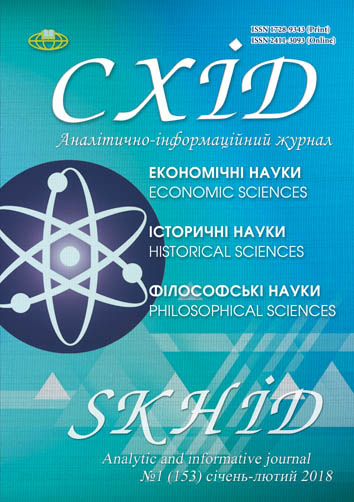Specificity of development of the theatrical life of Mariupol in the beginning of XX c.
DOI:
https://doi.org/10.21847/1728-9343.2018.1(153).127431Keywords:
theatrical life, Mariupol, repertoire, tours, amateurs, politicsAbstract
The article is dedicated to the development of theatrical art in Mariupol at the beginning of 20th century. The theatrical life of Mariupol has not been investigated yet as an original art phenomenon, and therefore, it demands for the detailed studying. There are the repertoire, the role of touring troupes and development of charitable activities of actors in the city described in the article as well. The information was collected from literature, newspapers and funds of local lore museums.
The study showed us the rising of ideological and educational value of the scene provincial theaters at the beginning of XX c. In Mariupol worked several theaters, which created conditions for the formation of theater seasons, touring groups' arrivals and also the base for the development of local amateur groups. Performances of guest performers - Ukrainian, Russian and foreign stars of theater scene contributed to the promotion and enrichment of theatrical culture, transforming Mariupol into the cultural centers of the region.
The author considers the features of the state policy in the sphere of theatrical art during the Civil War (1917-1920) and in the first years of Soviet government power. The Soviet government made a circle of attempts to use the theater in the business of agitation and propaganda as much as possible. In consequence with nationwide problems, the conditions which theater city institutions worked in, сconsiderably got worsened because of the fact of the demand of entertaining genres in the repertoire of the theaters. Nevertheless, thanks to the safekeeping of the best examples of the theatrical traditions, the priorities in the repertoire policy were given to the Ukrainian, Russian and foreign classics.
In conclusion, it may be said also, that theater in Mariupol at the beginning of XX c., was developed, despite the complications that have been appeared under the influence of existing political regime and differed from others in the existence of various professional and amateur groups, wide touring guest activities of the prominent masters of the stage and diverse repertoire.Downloads
References
Veselovska H. (2006), Modern and avant-garde theater in Ukraine the first third XX c., Essays on the history of theatrical art of Ukraine of the twentieth century, Institute of Contemporary Art Problems of the Academy of Arts of Ukraine, Intertechnology, Kyiv, pp. 159-220. (ukr).
Bozhko R., Buly T., Ganeshenko N. (Eds.). (2008), Mariupol and its surroundings: a glance from XXI century, Renata, Mariupol, 428 p. (rus).
Mariupolskaya zhizn. (1908), May 6. (rus).
Mariupolskaya zhizn. (1911), October 26. (rus).
Mariupolskaya zhizn. (1911), November 16. (rus).
Mariupolskaya zhizn. (1911), November 30. (rus).
Mariupolskaya zhizn. (1912), April 16. (rus).
Mariupolskaya zhizn. (1912), December 17. (rus).
Mariupolskaya zhizn. (1912), December 29. (rus).
Mariupolskiy vestnik. (1918), 46, October 23. (rus).
The Mariupol Municipal Local Lore Museum, MKM, KP 4864 845-К. (rus).
Mariupolskoe slovo. (1917). 54, June 9 (rus).
Petrov O. (2013), The theater life of Donetsk region in the 20-30’s. XX centuries, Bulletin of the Donbas National Academy of Civil Engineering and Architecture, Issue 2, pp. 64-71. (ukr).
Romanko, I. (1999), The development of theater art in Ukraine in 1917-1920: Extended abstract for obtaining scientific degree of candidate of historic sciences: 07.00.01. «History of Ukraine», Kyiv, 19 p. (ukr).
Semchyshyn M. (1993), Thousand Years of Ukrainian Culture, Kyiv, 550 p. (ukr).
Chuprik L. N. (1998), Scientific reference from the history of the Mariupol Theater, Archive of the Mariupol Local History Museum. F. 345. od. zb. 25-26, Mariupol, 28 p. (rus).
Yarutskiy L. (1991), Mariupol old times: Stories of the local ethnographer, Sovetskiy pisatel, Moscow, 432 p. (rus).
Downloads
Published
How to Cite
Issue
Section
License
Copyright (c) 2018 Olga Demidko

This work is licensed under a Creative Commons Attribution-NonCommercial-NoDerivatives 4.0 International License.
1. Authors bear responsibility for the accuracy of facts, quotations, numbers and names used.
2. Manuscripts are not sent back.
3. The publisher does not always agree with the authors' opinion.
4. The authors reserve the right to authorship of the work and pass the first publication right of this work to the journal under the terms of a Creative Commons Attribution-NonCommercial-NoDerivatives 4.0 International License. This license allows others to distribute (copy) the published work for non-commercial purposes, provided there is mandatory attribution to its authors and a link to the first publication in our journal.
5. The authors have the right to conclude separate supplement agreements that relate to non-exclusive work distribution in the form in which it has been published by the journal (for example, to upload the work to the online storage of the journal or publish it as part of a monograph), provided that the reference to the first publication of the work in this journal is included.

